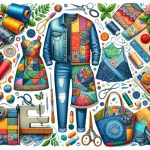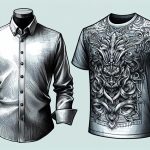Imagine finding an old, forgotten photograph that sparks a flood of memories—it's a bit like uncovering the potential in your outdated wardrobe. Upcycling old clothes isn't just about sustainability; it's a creative journey that breathes new life into your garments. By sorting your clothes by color and texture, gathering essential sewing tools, and mastering basic techniques, you can transform even the most worn-out pieces. Whether you're turning shirts into bags or adding unique embellishments, each step opens up new ways to refresh your style. Ready to explore the endless possibilities your old clothes hold?
Table of Contents
Key Takeaways
- Sort clothes by color and texture to streamline the upcycling process.
- Gather essential sewing tools like needles, threads, scissors, and a sewing machine.
- Learn basic sewing techniques such as hemming, fabric manipulation, and seam finishing.
- Experiment with patchwork designs by cutting and stitching different fabric shapes.
- Transform shirts into bags and jeans into shorts using precise cutting and sewing methods.
Sorting Your Clothes
Sorting your clothes is the first initial step in the upcycling process. Begin by evaluating each piece based on color coordination. Group items with similar hues together; this will help you visualize potential combinations that complement well.
Understanding fabric texture is equally essential. Place soft, delicate fabrics in one pile and more durable, sturdy materials in another.
After that, assess the clothing condition. Check for any stains, tears, or worn-out areas. Items in good shape can be directly repurposed, while those with minor issues might need some repair or creative concealment. This step ensures you're working with pieces that are valuable to your time and effort.
Next, think about your personal style. What do you enjoy wearing? Do you prefer casual, chic, or eclectic looks? Sorting clothes according to your style preferences will make the upcycling process more fulfilling and guarantee that the final products are things you'll actually want to wear.
Don't forget to think about how different textures can enhance your style. With your clothes sorted by color, texture, condition, and personal style, you're now ready to immerse into the creative world of upcycling.
Gathering Tools and Materials
Now that you've sorted your clothes, it's time to gather the essential sewing supplies you'll need. Make sure you have needles, threads, scissors, and a sewing machine handy.
Additionally, consider the fabric types you want to use to complement your upcycling projects.
Essential Sewing Supplies
To begin your upcycling journey, you'll need a well-stocked toolkit of essential sewing supplies. First and foremost, consider your fabric selection carefully. Your sewing machine will be your best companion, so make sure it's in good working condition. A variety of thread colors will help you match or contrast with the fabrics you choose, enhancing the aesthetic of your creations.
Next, gather an assortment of pins and needles. Different fabrics require different types of needles, so having a range on hand is essential. Pins will keep your materials in place, ensuring accurate stitching.
Here's a quick reference table for essential supplies:
| Tool | Purpose | Notes |
|---|---|---|
| Sewing machine | Stitching, hemming, and creating new designs | Regular maintenance is key |
| Thread colors | Matching or contrasting with fabric | Have a variety of colors available |
| Pins and needles | Holding fabric in place and stitching | Use appropriate types for different fabrics |
| Fabric scissors | Cutting fabric cleanly and accurately | Keep separate from other scissors |
| Measuring tape | Ensuring precise measurements | Essential for accurate sizing |
| Seam ripper | Correcting mistakes | A lifesaver for undoing stitches |
With these tools at your disposal, you're well-prepared to immerse yourself in the world of upcycling.
Choosing Fabric Types
When choosing fabric types, focus on the texture, durability, and flexibility to guarantee they suit your upcycling project.
First, consider fabric textures. Smooth fabrics like silk or satin work well for adding elegant touches, while rougher textures like denim or tweed bring a rustic, sturdy feel. By understanding the tactile qualities of different materials, you can better match them to your design vision.
Next, think about fabric patterns. Patterns can add a dynamic element to your upcycled pieces. Stripes and checks offer a classic look, whereas florals and abstract designs can make a bold statement. Mixing and matching patterns requires a keen eye, so practice blending different styles to create a cohesive final product.
Durability is another key factor. Fabrics like cotton or polyester blends are hard-wearing and suitable for items that will undergo frequent use.
Flexibility is equally important, especially for projects involving intricate sewing or draping. Stretchy materials like spandex or jersey knit allow greater ease in tailoring and fitting.
Basic Sewing Techniques
Mastering a few basic sewing techniques will empower you to transform old clothes into stylish new pieces. Start with hemming methods to make sure your garments have clean, professional edges. Whether you're shortening a dress or completing a raw edge, practice makes perfect. Focus on even stitches and consistent spacing.
Next, immerse yourself in fabric manipulation. Learn how to gather or pleat fabric to add texture and dimension to your designs.
Seam finishing is essential for durability and a polished look. Techniques like French seams or serging can prevent fraying and give your upcycled pieces a high-quality finish.
Don't overlook the impact of embroidery details. Simple stitches like the backstitch or chain stitch can add intricate designs that elevate any piece of clothing.
Your sewing machine is your best friend, but don't underestimate the significance of hand-sewing skills. Hand-sewn hems, buttons, and small repairs can be just as vital as machine work.
Invest time in learning these foundational techniques, and you'll find that your ability to upcycle clothing is limited only by your imagination. Master these basics, and you'll be well on your way to creating unique, stylish garments from your old clothes.
Creating Patchwork Designs
Once you've sharpened your basic sewing skills, you can start experimenting with creating patchwork designs to add a vibrant, personalized touch to your upcycled clothing. Begin by selecting fabrics that complement each other through thoughtful color coordination. This will guarantee that your final piece looks cohesive and visually appealing.
Gather old clothes with different textures and colors, and cut them into various shapes like squares, triangles, or hexagons to form creative patterns. Lay out your pieces on a flat surface to visualize your design before stitching them together. This step is vital for ensuring your patchwork aligns well and forms unique designs.
Remember, the beauty of patchwork lies in its versatility; you can customize sizes and shapes to fit any garment. Whether you're adding a patchwork pocket to a plain tee or creating an entire patchwork jacket, your creativity is your only limit.
When sewing your pieces, use a consistent seam allowance to maintain uniformity. Iron the seams flat for a polished look. By customizing sizes and experimenting with creative patterns, you'll transform ordinary clothes into stunning, one-of-a-kind masterpieces.
Your upcycled wardrobe will become a tribute to your skill and creativity.
Turning Shirts Into Bags
Transforming an old shirt into a handy bag is easier than you might think. You'll need a few basic materials like scissors, thread, and a sewing machine.
Follow these simple sewing steps, and you'll have a unique, eco-friendly bag in no time.
Materials You Need
To begin the process of turning old shirts into stylish bags, you'll need a few essential materials: a pair of scissors, a needle and thread or a sewing machine, and some pins. These items will help you convert your shirts into practical and trendy bags.
Start by considering your fabric options and color selection; choose shirts with sturdy material and vibrant colors to make your bags stand out.
Gather these necessary materials:
- Shirts: Opt for thicker fabrics like denim or heavy cotton.
- Scissors: Make sure they're sharp for clean cuts.
- Needle and thread or sewing machine: For efficient stitching.
- Pins: To secure your fabric in place while you work.
- Measuring tape: For precise dimensions.
As you set out on this upcycling journey, think about the countless upcycling ideas available to you. Transforming old shirts into bags isn't just a way to repurpose fabric; it's an opportunity for imaginative projects that showcase your personal style.
With the correct materials and a bit of patience, you'll create unique, environmentally friendly accessories.
Simple Sewing Steps
With your materials ready, let's start turning those old shirts into stylish, functional bags. Begin by choosing shirts with good fabric selection and color coordination to create a visually appealing bag. Lay the shirt flat and cut off the sleeves, making sure you leave the seams intact for added strength.
Next, turn the shirt inside out. Pin the bottom hem together and sew a straight stitch across, reinforcing it with a backstitch at the ends. This stitch pattern will guarantee the base of your bag is sturdy. For extra durability, consider using double stitching.
Now, let's focus on the handles. Cut two long strips from the leftover fabric. Fold each strip in half lengthwise, right sides together, and sew a straight stitch along the open edge. Turn the strips right side out and press them flat with an iron.
Attach the handles by pinning them inside the top edges of the bag, ensuring uniform spacing. Use hemming techniques to secure the handles with strong, neat stitches.
Transforming Jeans Into Shorts
Grab a pair of old jeans that no longer fit or have worn-out knees to turn them into stylish shorts. Start by laying the jeans flat on a table. Decide how long you want your shorts to be and mark the length with chalk. Remember, it's always better to cut them a bit longer initially; you can always trim more later.
Cut the legs off at your marked line, ensuring both sides are even. Once you've got the basic shape, it's time to distress the denim and create fraying edges for a trendy look.
Here's how to do it:
- Distress the denim: Use sandpaper or a cheese grater to roughen up the fabric around the cut edges.
- Fray the edges: Tug at the threads with a seam ripper or tweezers to create that casual, worn-in look.
- Customize the length: Try on the shorts and adjust the length as needed, making sure both legs match up perfectly.
- Hem the shorts: If you prefer a cleaner look, fold the edges and sew a simple hem.
- Wash and dry: Toss the shorts in the laundry to enhance the fraying and soften the fabric.
Adding Embellishments
Now that you have your customized shorts, let's make them unique with some fun embellishments. Start by exploring beadwork techniques. Choose beads that contrast or complement your fabric. Use a beading needle to stitch intricate patterns along the seams or pockets.
For a more traditional touch, colorful embroidery can add a vibrant flair. Pick a variety of threads to create eye-catching designs—floral patterns or abstract shapes will work wonders.
If you're aiming for a bit of sparkle, sequin decorations are your go-to. Position sequins in a random scatter or a defined pattern, and stitch them securely to avoid any falling off. Remember, the key to effective sequin work is consistency and precision.
Fabric appliqué offers another fantastic way to personalize your shorts. Cut out shapes or patterns from leftover fabric and carefully sew them onto your shorts. This technique doesn't just add visual interest but also reinforces the fabric, making it more durable.
Incorporating these embellishments will elevate your shorts from simple to standout. With your mastery of beadwork techniques, colorful embroidery, sequin decorations, and fabric appliqué, your upcycled shorts will truly be one-of-a-kind.
Dyeing and Painting Fabric
Transforming your old clothes with dyeing and painting techniques can infuse them with vibrant new life. By mastering these skills, you'll open a world of creative possibilities and stay ahead of fabric customization trends.
Start with tie dye techniques, a classic method that's making a strong comeback. Experiment with different folds and rubber band placements to create patterns like spirals, bullseyes, and stripes.
For fabric painting ideas, think beyond conventional brushes. Use:
- Sponges: Perfect for creating soft, textured backgrounds.
- Stencils: Ideal for precise designs and repeated patterns.
- Toothbrushes: Great for splatter effects and fine details.
- Stamping: Use everyday objects, like leaves or potatoes, to create unique imprints.
- Spray bottles: Achieve a misty, gradient effect effortlessly.
Mastering color mixing tips is essential for achieving the perfect hues. Always test your color combinations on a scrap piece of fabric first. Remember, fabric absorbs dye differently than paper, so adjust your proportions accordingly.
Incorporating these techniques not only revitalizes old garments but also aligns with current fabric customization trends. Whether you're aiming for bold, eye-catching designs or subtle, sophisticated accents, your creativity will shine through every piece you transform.
Repurposing Sweaters and Hoodies
Just as dyeing and painting breathe new life into fabrics, repurposing sweaters and hoodies can turn outdated wear into chic, functional pieces.
Begin with sweater pillows, a simple yet sophisticated project. Cut your sweater into squares, sew the edges, and stuff with filling. Voilà! You've got cozy, stylish pillows perfect for any room.
Next, transform a hoodie into a trendy handbag. Cut off the sleeves and sew the bottom shut. Use the hood as a built-in flap, adding a snap or button for closure. Attach a strap from the remaining fabric, and your hoodie handbag is ready to flaunt.
Sweater skirts are another versatile option. Cut the sweater horizontally just below the armpits. Hem the cut edge and add an elastic waistband for a comfortable fit. You now have a unique skirt that pairs well with various tops.
Lastly, consider making hoodie hats. Cut off the hood, ensuring you leave some fabric around the neckline. Hem the raw edges and add a drawstring if it didn't already have one. This easy project results in a custom, warm hat that stands out.
Frequently Asked Questions
How Do I Choose Which Clothes Are Best for Upcycling?
Choosing clothes for upcycling is an art! Focus on fabric selection and clothing evaluation. Seek pieces ripe for DIY projects, and let your creative ideas run wild. Trust your instincts, and you'll create masterpieces!
Can I Upcycle Clothes Without a Sewing Machine?
Yes, you can upcycle clothes without a sewing machine. Use no-sew upcycling techniques and DIY clothing transformations to get creative. Explore creative recycling ideas and draw fashion revamp inspiration to masterfully transform your old clothes.
Are There Any Specific Fabrics That Are Difficult to Upcycle?
Upcycling fabrics can be like finding your way through a maze; silk challenges your patience with its slippery texture, while leather difficulties arise from its tough and thick nature. Mastering these materials requires skill and a bit of persistence.
How Can I Make My Upcycled Items More Durable?
To make your upcycled items more durable, reinforce seams with sturdy stitching and consider using fabric glue on weak areas. These techniques will strengthen your creations, ensuring they last longer and maintain their new, improved forms.
What Are Some Eco-Friendly Ways to Dispose of Leftover Fabric Scraps?
Did you know 85% of textiles end up in landfills? You can help reduce this by composting scraps, donating fabric, or repurposing textiles for DIY projects. These eco-friendly methods guarantee your leftover fabric scraps don't go to waste.
- The Ultimate Guide to Choosing Tie-Dye Colors - July 14, 2025
- How Batching Time and Temperature Affect Tie-Dye - July 14, 2025
- The “Wet Powder on Dry Fabric” Tie-Dye Technique - July 14, 2025







